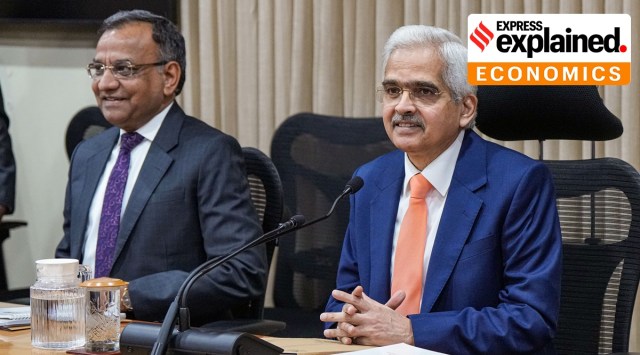This also assumes significance given that many global agencies have lowered India’s growth forecast for 2023-24 amid expectations of global economic slowdown and monetary tightening by other countries across the Atlantic.

The timing is also crucial, given that a high base effect during March-October was expected to ease pressure on the headline retail inflation rate, a phase when there are crucial state elections, and Lok Sabha elections are just over a year away.
The moderation in inflation rate forecast for FY24 to 5.2 per cent from 5.3 per cent earlier has imparted some breathing space to the RBI to pause its rate hike cycle, even as there are lingering concerns over the entrenched and high core inflation – the non-food, non-fuel component of inflation. The RBI also outlined risks from protracted geopolitical tensions, tight global financial conditions and global financial market volatility to its monetary policy outlook. “Global financial market volatility has surged, with potential upsides for imported inflation risks,” it said.
Just two months ago, in February, after the central bank’s customary post-budget central board meeting, RBI Governor Shaktikanta Das had justified the rate hike done then by saying the real interest rates had just turned positive after being in the negative territory for the last three years and the RBI’s rate actions were in line with “its objective of maintaining price stability”, as has been “mandated under the law”. Das had also said that negative real interest rates — a situation where the inflation rate is higher than the nominal interest rate — for a prolonged period of time “can create instability in the financial system”.
“Negative interest rates for a long time have a lot of risks which have to be avoided,” Das had said, when asked if the rate hikes by the RBI were affecting home loan EMIs and demand by homebuyers. He had also said that in a rising interest rate cycle, interest of depositors also needs to be taken into account and market competition will decide both deposit and lending rates.
From New Delhi’s perspective, in addition to the concerns over flagging consumption, there is continuing discomfort over tepid private investments, which have, in recent weeks, been accentuated by mounting global uncertainties. Last month, on March 16, Chief Economic Adviser V Anantha Nageswaran had called for building “margins of safety” amid global uncertainty, adding that real interest rates in India are not yet restraining enough to offset the buoyant demand for credit and double-digit credit growth because, according to him, it merely reflected improved balance sheet strength and the improved appetite for borrowing across sectors. Later at a seminar on March 29, while pointing to indications of a pick-up in the real estate cycle and private sector capital formation, he said private investors have been cautious given the recent global uncertainty and tightening of financial conditions.
Story continues below this ad
“The financial system has been repaired. Banks have been recapitalised, they have increased their provisions, non-performing asset ratios have come down and the corporate sector has de-leveraged… by the time we could start thinking of enjoying the repaired balance sheets, came the pandemic for two years and then came the commodity price shock, then came the interest rate shock of second half of 2022 and now we have potential tightening of financial conditions, which probably we haven’t fully put it behind us based on last 2-3 weeks of developments elsewhere. So, naturally some of these things do induce uncertainty in the minds of private investors and naturally they may be a little bit more cautious than they might have been,” he had said at a seminar organised by CSEP.
On Thursday, Union Finance Minister Nirmala Sitharaman said in a press conference in Karnataka that “RBI has taken a good call, I think”, news agency PTI reported.
The government had consistently leaned towards a benign pace of rate hikes by the RBI, citing decoupling of monetary policy stance followed by other central banks of developed economies. In September last year, Sitharaman had said policy actions of the RBI may not be synchronised as much as developed central banks. “The Reserve Bank will have to synchronise somewhat, may not be synchronised as much as developed central banks. I am not prescribing anything to the Reserve Bank, I am not giving any forward direction to the central bank. But it is the truth — India’s solution to handling the economy, part of which is handling inflation also, is an exercise where the fiscal policy together with monetary policy has been at work,” she had said.
Industry leaders predictably welcomed the decoupling of interest rate action by the RBI from global central banks. CII President Sanjiv Bajaj said, “We strongly welcome the RBI’s move to decouple from the global tightening cycle and pause interest rate hike, which is in line with what CII had been advocating for long now. We agree with the central bank’s observation that the lagged impact of the past rate hikes should be allowed to percolate into the system, and not stifle demand by further rate hikes.”
Story continues below this ad
Assocham Secretary General Deepak Sood said the RBI policy has made “a correct reading” of the global economy and its possible impact on India. “…in a way, the decision not to go in for any more rate increase would have surprised many as a larger expectation was a 25 basis points rise in the policy rates even as Assocham remained confident about the RBI striking a balance between reining in inflation and growth,” he said.








































